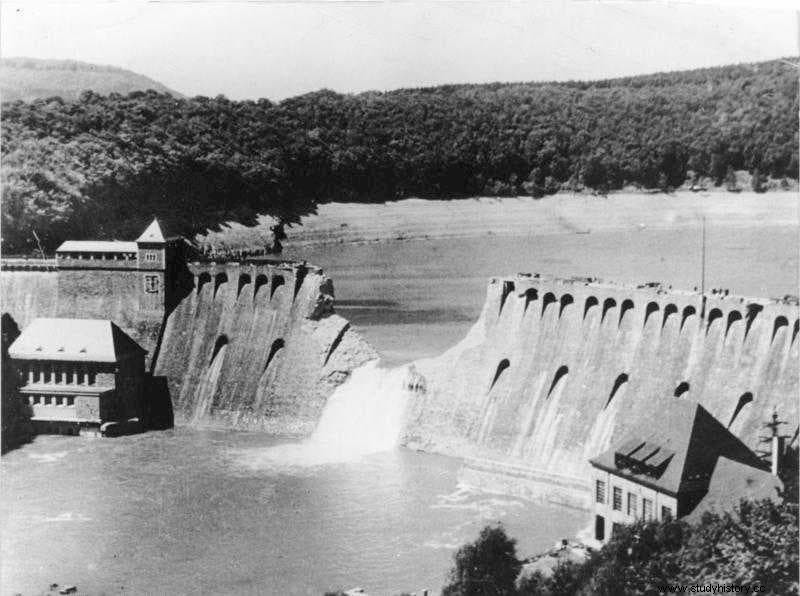On the night of May 16-17, 1943, an RAF squadron carried out a daring mission deep into German territory to destroy two dams in the Ruhr Valley, the industrial heartland of Germany.
The ensuing flood destroyed two hydroelectric power stations and several factories and mines, crippling Germany's steel and coal production. The mission was called Operation Chastise (Punishment).
One of the targets, the Möhne Dam in North Rhine-Westphalia, was the largest in Europe. It was built to help control flooding and ensure a water supply for much of the surrounding area. It was also used to generate hydroelectric power.

The British thought that the destruction of the dam and others in the Ruhr Valley would cause a massive disruption of German war production, since the valley's factories and industries depended heavily on the energy produced by these dams.
Germany knew that reservoirs and dams were a weak point in its defence, so it fiercely protected it with anti-aircraft guns and torpedo nets designed to catch any projectile launched into the water and traveling towards the dam wall. /P>
At first the British wanted to bomb the targets from above, but an immensely large bomb was needed to breach the dam. The same could be achieved with a smaller explosive charge if it were detonated against the dam wall underwater. They had to find a way to get past the torpedo nets.
Engineer Barnes Wallis found a solution:the bouncy bomb. Wallis devised a 4-ton bomb in the shape of a cylinder armed with a hydrostatic fuse, like depth charges. It was to be dropped by an aircraft flying very low above the surface of the water and released with a backspin that would cause the bomb to bounce off the surface of the lake, avoiding the torpedo nets, and hit the dam wall, with which would sink and explode at its base, dealing maximum damage.

A new squad was formed for the mission, called No. 617 Squad, later called Dam Busters , led by Commander Guy Gibson, 24, a veteran of more than 170 bombing and night-fighting missions. The crew of it consisted of pilots from Great Britain, Canada, Australia, New Zealand and the United States, each with a lot of experience under their belt.
The RAF carried out extensive tests at locations around the country. Testing revealed that the drum-shaped bomb, code-named Upkeep , had to be launched from a height of 20 meters and at a speed of 370 kilometers per hour, with a recoil spin of 500 rpm.
The delivery had to be precise, otherwise the bouncy bomb wouldn't work. In the absence of modern technology, the RAF came up with innovative solutions to every technical problem. To help determine the exact height, two floodlights were mounted under the planes, one under the nose and the other under the fuselage, so that at the correct height their beams of light would converge on the surface of the water. To determine the exact moment of the fall, a special device was built with ropes and spikes.
On the night of May 16, 1943, 133 crew members of 19 Lancasters took off in three waves towards the three objectives:the Möhne Dam, the Eder Dam and the Sorpe Dam. The formations deftly evaded German airbases and known flak positions, flying in and out of Germany before turning south to head for the Mohne River.

To avoid radar detection, the bombers flew at only 30 meters altitude. At one point, Sergeant George Chalmers was surprised to see his pilot flying toward the target along a forest firebreak, below treetop level.
It took five attempts before the Möhne dam broke. The attack left a huge hole in the dam, 250 feet in diameter, through which floodwaters spilled into the valley, washing away more than a hundred factories and almost a thousand houses, as well as dozens of roads, railways and bridges. . The small town of Neheim-Hüsten was also hit with more than 800 victims.
Elder Dam was not defended with flak positions, but the topography was challenging, requiring the bombardment team to make multiple runs before they could get the angle of attack correct. The dam was pierced by a hole 70 meters wide, and the resulting flood inundated the valley up to 30 kilometers downstream. The attack on the Sorpe dam failed.
RAF pilots suffered heavy losses. Of the 19 bombers that participated in the operation, 8 were shot down and almost half of the crew lost their lives.

It has been estimated that more than 1,500 civilians were killed, a large number of whom were Russian prisoners of war held in a camp located downstream of the Möhne Dam. Thousands of cattle, pigs, horses, and smaller animals such as goats and sheep perished with the people.
The attack made an impressive dent in Germany's coal and steel production, but the impact was not enough to change the course of the war. Ruhr steel production fell by a quarter and coal production by 400,000 tons, mainly because the bombs brought down the two hydroelectric power stations, plunging the region into darkness for two weeks.
Both dams were repaired within a few months, and in the absence of follow-up raids to hamper reconstruction, Operation Chastise failed to provoke any long-term crisis, as the British War Office hoped.
This article was published on Amusing Planet. Translated with permission.
